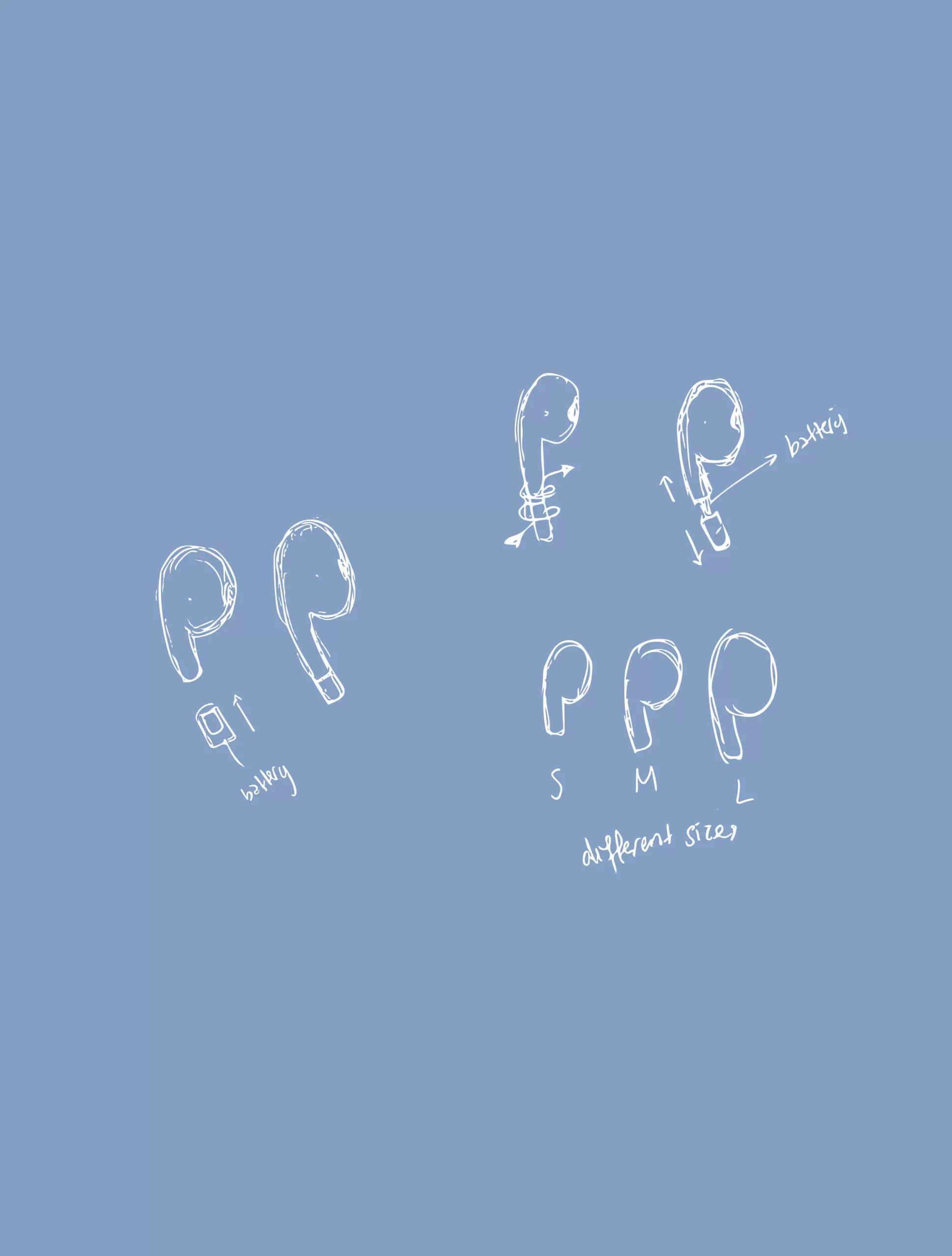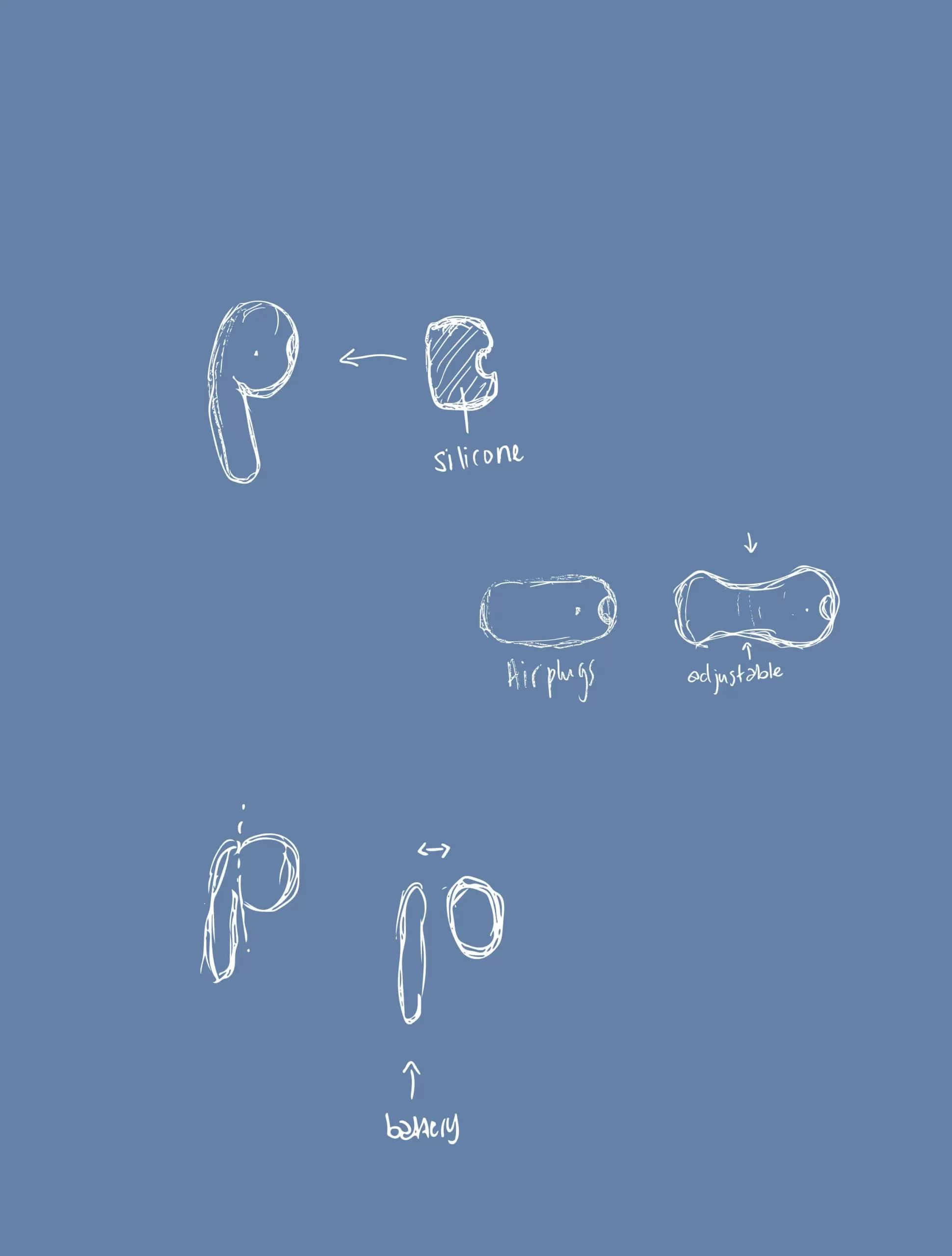Redesigning the AirPods
This school project involves selecting a product of choice, identifying problems associated with it, and developing solutions to address those problems.
Role: Researching, Concepting, UX design, Testing
Design tools: Illustrator
One size fits all?
AirPods, despite their popularity, don’t fit everyone comfortably due to their one-size-fits-all design. Every person’s auricle—the outer part of the ear—is shaped differently, with some people having smaller or larger auricles. This means that for those with a deviated ear shape, AirPods may not fit securely. Additionally, the smooth material on the exterior of AirPods can cause them to easily slip out of the ear, as it provides little grip.
Not environmentally friendly
AirPods pose significant environmental challenges due to their difficult recyclability (Nellis, 2016). The design of AirPods makes them extremely hard to disassemble (Wiens, 2016), as the exterior is glued and taped together. This adhesive material cannot be loosened with heat, making it nearly impossible to take the AirPods apart without damaging them. This issue is compounded by the fact that AirPods use lithium-ion batteries, which, although offering benefits such as high energy density, low self-discharge, no memory effect, high power, and long service life (“What you need to know about Lithium Ion batteries,” 2015), only have a lifespan of about three years. Once the battery’s life ends, replacing it becomes a challenge given the AirPods’ sealed design.
While Apple has a long history of publishing detailed environmental reports for its products, which include information on the materials used, energy efficiency, and estimated greenhouse gas emissions (Mens, 2019), there is a notable absence of such a report for AirPods. This lack of transparency raises concerns, as it seems that Apple might not want to disclose certain details to its consumers or the public. As a designer committed to a better living environment and honesty, I find this product ethically questionable in its responsibility towards both people and the planet.
Image source: https://www.idownloadblog.com/2016/12/20/teardown-analysis-suggests-airpods-charging-case-quality-issues-may-have-delayed-launch/
Ideation
For the two problems I identified with AirPods—poor fit due to the one-size-fits-all design and their environmental impact—I began brainstorming potential solutions. After considering various ideas, I selected the three that seemed most promising for further development. These solutions addressed the key issues of fit and sustainability while aligning with the goals of improving user experience and environmental responsibility.
Prototype 1 for problem one-size-fits-all:
To improve the fit of AirPods, I proposed creating silicone covers that can be slipped over the earbuds. These covers would help the AirPods stay snug in the ear, accommodating different ear shapes and sizes while providing additional grip to prevent them from slipping out.
Prototype 2 for problem one-size-fits-all:
This is really obvious, but… providing different sizes, so users could select the pair that best fits their ear shape, ensuring a more comfortable and secure fit. This approach would cater to the diverse range of ear sizes and shapes, making the product more inclusive and user-friendly.
Prototype 3 for problem one-size-fits-all:
This solution involves designing AirPods into adjustable ear buds made from a memory foam-like material. This material would adapt to the unique shape of each user’s auricle, providing a custom fit. The memory foam would mold to the ear’s contours, ensuring a snug and secure fit that is both comfortable and stable. This approach would not only enhance the listening experience but also make the AirPods more inclusive by accommodating a wider range of ear shapes and sizes.
Prototype 1 for environmental problem:
To address the environmental issues, a potential solution would be to design AirPods with a feature that allows for easy battery removal. This would enable users to replace the battery when needed, extending the product’s lifespan and reducing electronic waste. By making the battery accessible, the AirPods could be more easily recycled, as components could be separated without damaging the device. This approach not only promotes sustainability but also aligns with ethical design practices, ensuring that the product is more environmentally responsible.
Prototype 2 for environmental problem:
This prototype is similar to Prototype 1, but instead of opening at the ear tip, it features an opening at the part that goes into the ear.
Prototype 3 for environmental problem:
Prototype 3 is also similar to Prototype 1, but instead of having a removable shell, it integrates the battery and shell into a single, cohesive piece. This design simplifies the construction and reduces potential points of failure while still addressing the need for easy battery replacement.
End prototype
This prototype addresses both identified issues with a dual-function design. The battery removal feature is integrated into the ear tip, where the sound exits, making battery replacement easier. Additionally, this design allows the ear tip, which fits into the auricle, to be interchangeable in various sizes. This approach ensures a customizable and user-friendly experience by accommodating different ear shapes and sizes while also addressing sustainability concerns.
Ideation
For the two problems I identified with AirPods—poor fit due to the one-size-fits-all design and their environmental impact—I began brainstorming potential solutions. After considering various ideas, I selected the three that seemed most promising for further development. These solutions addressed the key issues of fit and sustainability while aligning with the goals of improving user experience and environmental responsibility.
Prototype 1 for problem one-size-fits-all:
To improve the fit of AirPods, I proposed creating silicone covers that can be slipped over the earbuds. These covers would help the AirPods stay snug in the ear, accommodating different ear shapes and sizes while providing additional grip to prevent them from slipping out.
Prototype 2 for problem one-size-fits-all:
This is really obvious, but… providing different sizes, so users could select the pair that best fits their ear shape, ensuring a more comfortable and secure fit. This approach would cater to the diverse range of ear sizes and shapes, making the product more inclusive and user-friendly.
Prototype 3 for problem one-size-fits-all:
This solution involves designing AirPods into adjustable ear buds made from a memory foam-like material. This material would adapt to the unique shape of each user’s auricle, providing a custom fit. The memory foam would mold to the ear’s contours, ensuring a snug and secure fit that is both comfortable and stable. This approach would not only enhance the listening experience but also make the AirPods more inclusive by accommodating a wider range of ear shapes and sizes.
Prototype 1 for environmental problem:
To address the environmental issues, a potential solution would be to design AirPods with a feature that allows for easy battery removal. This would enable users to replace the battery when needed, extending the product’s lifespan and reducing electronic waste. By making the battery accessible, the AirPods could be more easily recycled, as components could be separated without damaging the device. This approach not only promotes sustainability but also aligns with ethical design practices, ensuring that the product is more environmentally responsible.
Prototype 2 for environmental problem:
This prototype is similar to Prototype 1, but instead of opening at the ear tip, it features an opening at the part that goes into the ear.
Prototype 3 for environmental problem:
Prototype 3 is also similar to Prototype 1, but instead of having a removable shell, it integrates the battery and shell into a single, cohesive piece. This design simplifies the construction and reduces potential points of failure while still addressing the need for easy battery replacement.
End prototype
This prototype addresses both identified issues with a dual-function design. The battery removal feature is integrated into the ear tip, where the sound exits, making battery replacement easier. Additionally, this design allows the ear tip, which fits into the auricle, to be interchangeable in various sizes. This approach ensures a customizable and user-friendly experience by accommodating different ear shapes and sizes while also addressing sustainability concerns.
You’ve reached the end 🥳
© 2024 anna by Anna Tai


